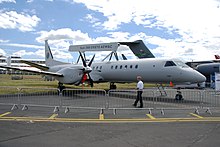|
Erieye
The Erieye radar system is an Airborne Early Warning and Control System (AEW&C) developed by Saab Electronic Defence Systems, formerly Ericsson Microwave Systems, of Sweden. It uses active electronically scanned array (AESA) technology. The Erieye is used on a variety of aircraft platforms, such as the Saab 340 and Embraer R-99. It has recently been implemented on the Bombardier Global 6000 aircraft as the GlobalEye. The Erieye Ground Interface Segment, EGIS, not to be confused with the Aegis combat system, is a major component of the software used by the Erieye system. The radar provides 300 degree coverage and has an instrumental range of 450 km and detection range of 350 km in a dense hostile electronic warfare environment—in heavy radar clutter and at low target altitudes. The radar is capable of identifying friends or foes, and has a sea surveillance mode. The Erieye system has full interoperability with NATO air defence command and control systems. History In 1985, Ericsson Microwave Systems were contracted by the Swedish Defence Material Administration to develop what would become the PS-890 Erieye AEW radar. In 1985, a dummy dual-sided phased array antenna was tested on a twin-engined Fairchild Metro aircraft. In 1987, the Metro aircraft was fitted with the radar system for flight trials. In 1993, production started on six radars for the Swedish Air Force, for fitting in Saab 340 aircraft. In 1996, the first two production radars were delivered. The name Erieye is short for Ericsson eye. Operational historyPakistanOn 16 August 2012, nine Tehrik-e-Taliban militants assaulted PAF Base Minhas at about 2 am. After a pitched battle all nine attackers were killed while two Pakistani security officials also died.[1][2] The militants allegedly also destroyed one Saab 2000 Erieye plane[3] and allegedly damaged one[4] or two other aircraft.[5]  In February 2019, the Pakistan Air Force launched retaliatory airstrikes on Indian military installations in Indian Administered Jammu and Kashmir in response to India's violation of Pakistani airspace and the bombing of a wooded area at Balakot. While fighter jets from various PAF squadrons executed the airstrikes, Saab-2000 Erieye AWACS along with DA-20 EW supported them throughout the operation.[6][7] Design  The Erieye AEW&C mission system radar is an active, phased-array, pulse-doppler sensor that can feed an onboard operator architecture or downlink data, via an associated datalink subsystem, to a ground-based air defence network. The system employs a large aperture, dual-sided antenna array housed in a dorsal 'plank' fairing. The antenna is fixed. The beam is electronically scanned, which provides for improved detection and significantly enhanced tracking performance, compared with radar-dome antenna systems. Erieye detects and tracks air and sea targets out to the horizon, and sometimes beyond this due to anomalous propagation — instrumented range has been measured at 450 kilometres (280 mi). Typical detection range against fighter-sized targets is approximately 425 kilometres (264 mi), in a 150° broadside sector, both sides of the aircraft. Outside these sectors, performance is reduced in forward and aft directions. Other system features include: Adaptive waveform generation (including digital, phase-coded pulse compression); Signal processing and target tracking; track while scan (TWS); low side lobe values (throughout the system's angular coverage); low- and medium-pulse repetition frequency operating modes; frequency agility; Air-to-air and sea surveillance modes; and target radar cross-section display. The radar operates as a medium- to high-PRF pulse-Doppler, solid-state radar, in E/F-band (3 GHz), incorporating 192 two-way transmit/receive modules that combine to produce a pencil beam, steered as required within the operating 150° sector each side of the aircraft, one side at a time. It is understood that Erieye has some ability to detect aircraft in the 30° sectors fore and aft of the aircraft heading, but has no track capability in this sector.[8] DevelopmentGlobalEye consists of a suite of sensors using Erieye ER (Extended Range) radar and mission system, installed in the Bombardier Global 6000 long-range business jet.[9] Operators
Applications
References
External links
|
||||||||||||||||||
